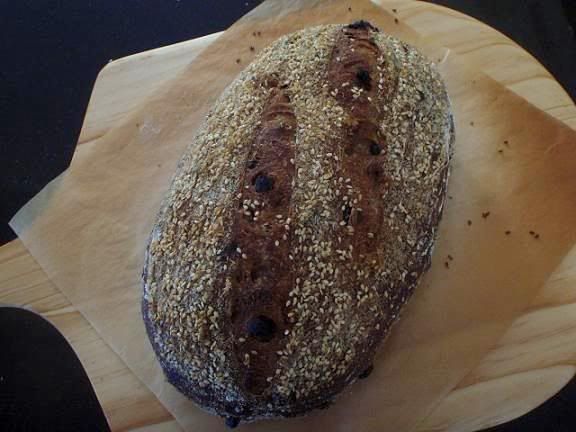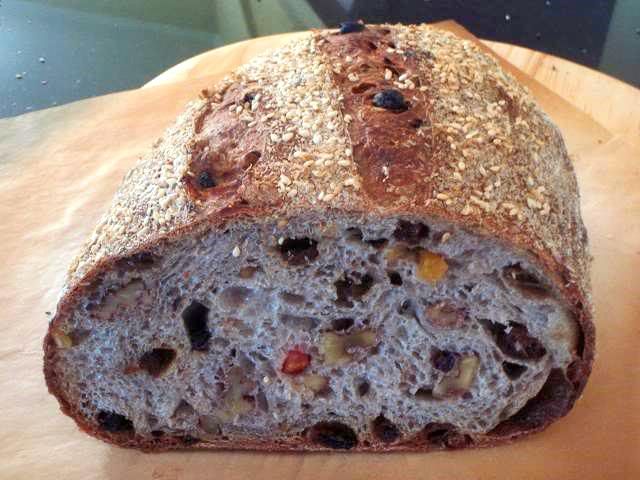First of all, I have to say that I feel uncomfortable every time when I refer to MacGuire's set of procedure Pain de Tradition procedure. As I indicated in my first post that, in the Winter 2006 issue of The Art of Eating magazine, Nos 73+74 (note: a 20th Anniversary Double Issue) where I got this method, it is entitled "A Full-Flavoured, Minimum-Kneading, All-Included Recipe for a Round Loaf with Many of the Advantages of the Baguette." I said that essentially this is an old-style straight-dough, super-hydrated formula which can also be used for baguette. I call it Pain de Tradition because, from reading MacGuire's 10 page article entitled "The Baguette" about Prof. Calvel, I understand it to be a bread using the traditional method seen in Prof. Calvel's younger days, ie. slow & gentle mixing and long cool fermentation (but of course the actual steps that I relayed were developed by Mr. MacGuire). The article is beautifully written and extremely informative. I don't want to mislead anybody or misrepresent Mr. MacGuire and I would encourage anyone who is interested in more details to visit Edward Behr's The Art of Eating website and get a back issue.
Another very important point which I did not mention in my first post is the choice of flour. MacGuire is very careful of what flour he uses for his straight-dough baguette. He does it only if the flour is "right." He dedicates a big section in his article about the differences between French and North American flours, which is a familiar topic for TFL users here. Suffice to say that, for want of a basic French flour (the type 55), MacGuire uses King Arthur's All-Purpose Flour instead. (It may not be acceptable to him but nothing says we cannot experiment with any flours we like - this is the prerogative of home cooks.)
That said, I had a load off my chest. Phew! Now I can get on with the important stuff of this post.
I love fruits and nuts in my breads. (How interesting - sorry to go back to my inspiration again - that MacGuire reveals that Calvel "retained his generation's disdain for whole-wheat flour, saying, 'Just as we peel oranges, wheat's outer layer is removed'" and that Calvel "insisted that the bread he ate in his youth was as white as today's." Furthermore, he adds, "Except for walnuts or raisins, he (ie, Calvel) disdained such non-grain ingredients in bread." !!)
Ever since I learned how to operate a bread machine some 6 or 7 years ago, I've been quick in trying to make my own walnut and raisin breads. It is like someone who can barely walk properly, already tries to run. I love to add all sorts of fun stuff into my breads, and I am very greedy too - I love to add a lot of it vis-a-vis the flour quantity. For some reason I have never had great results with walnut and raisin breads though.
Armoured with the new found procedure from master baker James MacGuire, I thought I'd give it another go.
My formula follows:
230 g starter @75% hydration (ie, 132 g white flour & 98 g water)
318 g KAF Sir Lancelot high-gluten flour (On hindsight, All-Purpose flour would have been better; the crumb may even be more open.)
257 g water
100 g walnuts (I was going to lightly toast them, but my bag of walnuts is new and the walnuts tastes crisp, so I didn't.)
125 g mixed fruits (Predominantly sultanas, there are also raisins, citrus peels and currants. I did not soak them because they taste moist.)
5 g sesame oil (or one tsp)
1 tsp of cinnamon powder
9 g salt
sesame seeds and fine psyllium husks for dusting the banneton and the shaped loaf
total flour = 450 g and total hydration (including oil) = 360 g; ie, dough hydration = 80%
nuts and fruits = 50% of flour, which is higher than Hamelman's fruits & nuts based bread and/or sourdough recipes (ranging from 25 - 32%) but a lot less than Reinhart's Cinnamon Raisin Walnut Bread recipe (80%) which David rendered beautifully in his June 22 post here.

Sourdough Walnut & Sultana Bread - using James MacGuire's pain de tradition procedure

the crumb

and the close-up
the calculation of water temperature when sourdough starter is used
When there is a sourdough starter, there is one more element to consider in the calculation of water temp for the final dough. I did not mention this when I posted my San Francisco Sourdough Bread. I use the mid-range temp of 71 - 75 F (22 - 24 C) for the ideal dough temperature, ie, 73 F (22 C), as a base to add to the figure we already have, that is 216 F, to arrive at the new starting figure for calculation.
216 F + 73 F = 289 F
289 F - room temp - flour temp - starter temp - 5 = water temp (bearing in mind this is for hand mixing)
This may not be correct in the strictest sense, but I get a rough gauge as to what water temp I should be aiming for. (Susan's Wild Yeast blog may have something more accurate, but I cannot remember.)
mixing and fermentation
With this bread, I didn't want to bother with the two-step mixing that most recipes would have you do, ie, mixing the flours with the water first, autolyse, then mixing in all the fruits & nuts. I basically gave the flour a reluctant stir in the starter/water mixture for no more than 5 - 10 seconds, added the fruits and nuts straight away, then at this point I did a good stir for a minute or two. Autolysed for 10 min as in MasGuire's instruction, then performed my first set of 8 - 10 folds.
By the time I finished all 5 sets of 8 - 10 folds, it was half past 11 last night. I shaped the dough, rolled it lightly in a mixture of sesame seeds and fine psyllium husks (a bit like very fine bread crumbs). I dusted the benetton lightly again with this sesame seeds mixture, placed the shaped dough in there, covered the whole thing in a plastic bag, and chucked it into the refrigerator for retardation. Brought it out to room temp this morning at 7 and baked it at 8:30 for 50 minutes.
the result
My husband is no expert in breads, or sourdough for that matter. But, hey, we are here to please our family. By no means are our family's standards those of professionals. But, if our family is happy, we are happy.
My husband said the bread is just brilliant! He said the flavors are well balanced, you cannot discern any individual flavor, nothing is dominant that you can pick up. He alone had 1/3 of the loaf with morning tea!
Don't we love a biased family member.
Shiao-Ping
p.s. My daughter, just home from school, was munching a piece of this bread. I showed her my draft, she goes, "No, you are not there to please family members, you are there to please yourself! Isn't that what you've always told us!" Ahh, that is my girl.